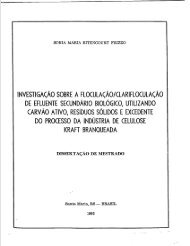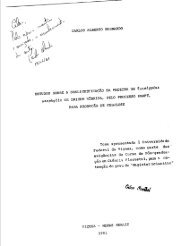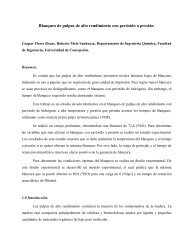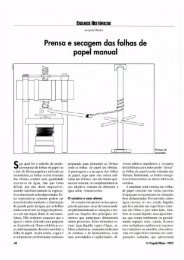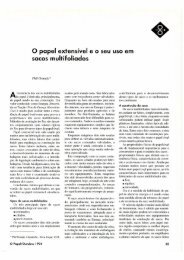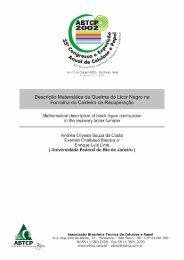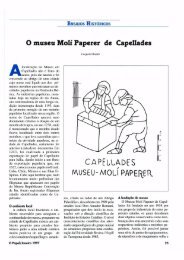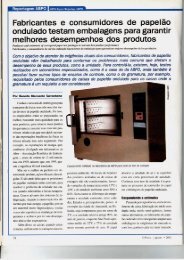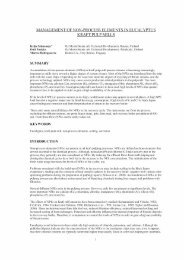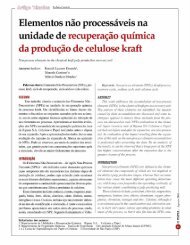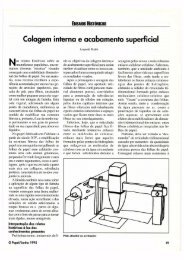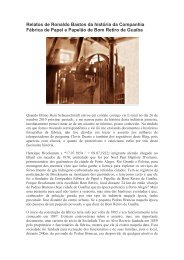O Eucalipto: um século no Brasil (The Eucalypt - Celso Foelkel
O Eucalipto: um século no Brasil (The Eucalypt - Celso Foelkel
O Eucalipto: um século no Brasil (The Eucalypt - Celso Foelkel
You also want an ePaper? Increase the reach of your titles
YUMPU automatically turns print PDFs into web optimized ePapers that Google loves.
Do ponto de vista científico, o eucalipto faz o papel das árvores pioneiras das florestas, isto<br />
é, suporta plena insolação, o que outras árvores não agüentam, como o palmito da Mata<br />
Atlântica, do gênero ‘Euterpes’, que prefere se desenvolver na sombra.<br />
Modernamente, as plantações florestais são feitas com pouco trabalho <strong>no</strong> solo,<br />
continua a ensinar o professor Poggiani. Para se plantar eucalipto, o terre<strong>no</strong> não é limpo<br />
como <strong>no</strong> passado. O sistema de “cultivo mínimo” consiste em fazer <strong>um</strong> sulco com o subsolador<br />
que descompacta o solo a <strong>um</strong>a profundidade média de 40 centímetros. Nesse sulco<br />
é colocado o adubo e plantadas as mudas, em linhas distantes três metros entre si, cada<br />
futura árvore a dois metros da próxima.<br />
Entre as linhas, por vezes é espalhado calcário, não tanto para correção do pH, pois o eucalipto<br />
tolera a acidez do solo, mas para ajudar a solubilização do fósforo, do qual é muito<br />
deficiente. É que os terre<strong>no</strong>s usados para o plantio do eucalipto são pobres, porque regra<br />
geral são usadas áreas originalmente ocupadas por matas que foram derrubadas para o<br />
plantio do café ou da cana, e quando foram eliminados, o terre<strong>no</strong> foi aproveitado como<br />
pasto natural, jamais adubado, pois não era cost<strong>um</strong>e cultivar pastos <strong>no</strong> <strong>Brasil</strong>.<br />
Quando o pasto retirava nutrientes da terra e era ingerido pelo gado, a terra se acidificava.<br />
No cômputo final, a riqueza do solo estava sendo transformada em carne que era cons<strong>um</strong>ida<br />
nas cidades, empobrecendo o solo que, pouco coberto, não só ficava mais ácido, como<br />
sujeito à erosão.<br />
A erosão resultou em grandes grotas, as chamadas voçorocas, que se espalham pelos<br />
terre<strong>no</strong>s de antigo cultivo. Contribuem para que a terra, lavada, seja carregada para os rios,<br />
provocando assoreamento. A solução é controlar a erosão com o plantio de eucalipto. É isso<br />
que é feito pelas grandes empresas florestais que usam o eucalipto para conservação do<br />
solo, segurando a erosão, para dar condições de que as espécies nativas brotem dentro das<br />
voçorocas, sustando finalmente o processo de desgaste.<br />
A S U S T E N T A B I L I D A D E D A S F L O R E S T A S - F O R E S T S U S T A I N A B I L I T Y<br />
77<br />
<strong>Eucalipto</strong> como pioneira<br />
<strong>Eucalypt</strong> as a pioneer<br />
From the scientific viewpoint, eucalypt plays the role of the forest’s pioneer tree, i.e., it<br />
can take the sun beating on it directly, something other trees can’t withstand, such as<br />
the Atlantic Forest palm tree, of the Euterpes genus, which prefers the shade.<br />
In modern days, little work is done on the soil before a forest is planted on<br />
it, the professor Poggiani goes on. To plant eucalypt, the soil is <strong>no</strong>t cleaned, as it used<br />
to be in the past. <strong>The</strong> “minim<strong>um</strong> cultivation” system consists in making a groove with<br />
the subsoiler, which de-compacts the soil at an average depth of 40 cm. <strong>The</strong> fertilizer is<br />
placed and the seedlings are planted in this groove, spread in grooves that are 3 meters<br />
away from each other, while each future tree is planted two meters apart from the other.<br />
Sometimes, limestone is spread between the grooves, <strong>no</strong>t so much to correct the pH,<br />
as eucalypt tolerates soil acidity well, but to assist in phosphor solubilization, which<br />
it is very deficient of. <strong>The</strong> fact is that the soil used to plant eucalypt on is poor, largely<br />
because they were areas that were originally occupied by forests that were slashed in<br />
order for the land to be used to plant coffee or sugarcane crops, which, after eliminated,<br />
gave way to natural pasture, which was never fertilized, as it was never a habit to<br />
cultivate pastures in Brazil.<br />
When the pasture removed the soil’s nutrients and was ingested by cattle, the ground<br />
became acidic. In s<strong>um</strong>, the soil’s richness was being turned into meat, which was cons<strong>um</strong>ed<br />
in the cities. <strong>The</strong> soil became poor in resources and, because it was <strong>no</strong>t covered<br />
<strong>no</strong>t only became more acidic, but, also, subject to erosion.<br />
Erosion later resulted in major grottos, the so-called “voçorocas,” which spread all over<br />
the old cultivation land and contribute to the soil being dragged to the rivers, causing sedimentation.<br />
This erosion is <strong>no</strong>w controlled with eucalypt plantations. That is what major<br />
forest companies that use eucalypt to conserve the soil, preventing erosion and giving<br />
native species conditions to sprout in the grottos and, finally, impede the wear process.




